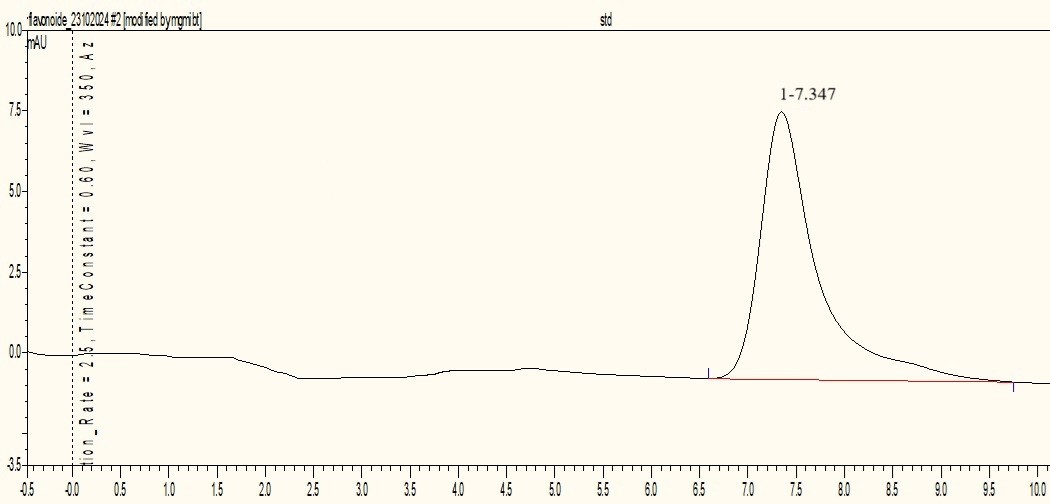Flavonoids are polyphenolic compounds known for their antioxidant properties and various health benefits. The current study focused on the evaluation and quantification of flavonoids Morin, Naringin, Quercetin, and Rutin in Mango (Mangifera indica) leaves. High-Performance Liquid Chromatography (HPLC) is employed for the qualitative analysis of these compounds using a reverse-phase column with 0.1% phosphoric acid and acetonitrile in a 25:75 ratio. The standard retention times for Quercetin, Morin, Naringin, and Rutin were 2.513 min, 3.887 min, 7.130 min, and 4.780 min, respectively. In Mango leaf extracts, Quercetin, and Morin are identified at retention times of 2.593 min, and 3.393 min respectively, these results confirm the presence of key flavonoids with potential health benefits in Mango leave.
Flavonoids, polyphenolic compounds, antioxidant, HPLC, retention time.
Mango (Mangifera indica) is a tropical fruit belonging to the family Anacardiaceae, known for its rich flavor, vibrant color, and numerous health benefits. It is native to South Asia but is now cultivated in many tropical and subtropical regions around the world. Mangoes are highly nutritious and are a rich source of vitamins, minerals, and phytochemicals that contribute to their health-promoting properties [1]. Phytochemicals in mango include phenolic acids, carotenoids, and various polyphenols. The most prominent flavonoids present in mangoes are mangiferin, quercetin, kaempferol, catechins, and anthocyanins. These compounds exhibit powerful antioxidant, anti-inflammatory, and anticancer activities. Mangiferin, for instance, is unique to mangoes and possesses a wide range of biological activities, including neuroprotective and antidiabetic properties [2]. Quercetin's chemical structure consists of a flavonol backbone, with hydroxyl groups (-OH) attached to positions 3, 5, 7, 3', and 4' of the flavonoid nucleus. This molecular structure gives quercetin its antioxidant and free radical scavenging properties. It is abundant in many plant-based foods, serving as a natural colorant and contributing to their health-promoting properties. Health Benefits of quercetin has been studied for various potential health benefits [3-4]. Rutin, also known as quercetin-3-rutinoside, is a flavonol glycoside composed of quercetin (aglycone) and the disaccharide rutinose (rhamnose-glucose). Its yellow crystalline appearance characterizes it. Rutin is commonly found in foods such as buckwheat, citrus fruits (especially citrus peels), apples, berries, and some medicinal herbs [5-6]. Carotenoids like beta-carotene contribute to the fruit's yellow-orange hue and offer vision health benefits due to their role as precursors to vitamin A. The fruit is also rich in vitamins C, E, and folate, all of which support immune function, skin health, and cellular repair [7]. The consumption of mangoes has been linked to numerous health benefits. They are known to support digestive health due to their fiber content, promoting regular bowel movements and preventing constipation. Mangoes also help in boosting immunity, thanks to their high vitamin C content, which aids in the production of white blood cells [8]. The antioxidants in mangoes, particularly quercetin and mangiferin, help neutralize free radicals, reducing oxidative stress, and lowering the risk of chronic diseases such as heart disease and cancer. Additionally, the presence of anti-inflammatory flavonoids supports overall cardiovascular health by improving blood circulation and reducing cholesterol levels [9].
Mangifera Indica L. Nutrition value per 100g, Energy 60Kcal, Fruit composition Quantity Carbohydrates 14.98g, Protein 0.82g, Fat 0.38g, Fiber 1.6g) Vitamins (VitaminC 36.4mg, Vitamin E 1.12mg, Vitamin A 1082IU, Niacin (vitB3) 669 g, Pantothenic acid (vitB5) 160 g Pyridoxine (vitB6) 119 g, Riboflavin (vitB2) 38 g, Thiamin (vitB1) 28 g, Folates 43 g, and VitaminK 4.2g) and Minerals (Potassium 168mg, Phosphorus 14mg, Calcium 11mg, Magnesium 10mg, Sodium 1mg, Copper 110g, Iron 160g, Manganese 27g, Zinc 90g, Carotenoids Carotene 445g, Carotene 17) [9].
Methodology
Preparation and extraction of plant extract:
We will collect the leaves samples both newborn and grown leaves. We will dry the leaves by using the shed dry method. We will crush the leaves using molten and pistil until it's a fine powder. The powder will be stored in a dark drawer till use.
Soxhlation
Samples are prepared and weighed 20 grams. The apparatus is cleaned using ethanol. The sample and solvent system are loaded into the apparatus. The apparatus was kept in the heating mantel at 30?. The eight cycles of Soxhlation have been taken. The extract was stored at room temperature for further analysis [10].
HPLC (High-performance liquid chromatography)
High-Performance Liquid Chromatography (HPLC) is a technique used to separate, identify, and quantify compounds in a mixture. The preparation of the mobile phase typically consists of a mixture of water, organic solvents, and buffers at a specific pH. The sample is prepared by dissolving it in a suitable solvent and then filtered through a 0.22 or 0.45 µm filter to remove particulates. The HPLC system consists of a pump, injector, column, and detector. The mobile phase is pumped through the column at a constant flow rate, and the sample is injected into the system using an autosampler or manual injector. The column separates the compounds based on their interactions with the stationary phase. The separated components are detected by a UV-Vis detector or other suitable detectors [11].
The elution is monitored, and the retention times of the compounds are recorded. The data are analyzed to determine the concentration and purity of the analytes based on the peak areas or heights. After the analysis, the column is typically flushed with a high proportion of organic solvent to remove residual compounds and maintain column performance.
RESULT
The HPLC analysis of the standard is performed using an RP column, with a mobile phase consisting of 0.1% of H3PO4 + Acetonitrile in a ratio of 25:75 at a flow rate of 1 mL/min. The detection is carried out at a wavelength of 350 nm, and the column temperature is maintained at 37 °C. The injection volume is 20 µL. The retention time for Quercetin, Morin, Naringin, and Rutin are 2.513 min, 3.887 min, 7.347 min, and 4.780 min, respectively, depicted in Fig.1- 4.
The HPLC analysis of the sample also followed the same protocol as the standard performed. The retention time of Quercetin is observed at 2.593 min, with a peak area of 57.1761mAU*min, And Morin is observed at 3.393min with a peak area of 201.3511mAU*min. observe in Fig.5.

Fig:1 Standard Chromatogram of Morin

Fig.2 Standard Chromatogram of Naringin

Fig.3 Standard Chromatogram of Quercetin

Fig.4 Chromatogram of Standard rutin.

Fig.5. Chromatogram of Mango


 : Dr. Raja Kumar Parabathina* 1
: Dr. Raja Kumar Parabathina* 1
 Sunil Kothargasti 2
Sunil Kothargasti 2





 10.5281/zenodo.14197490
10.5281/zenodo.14197490